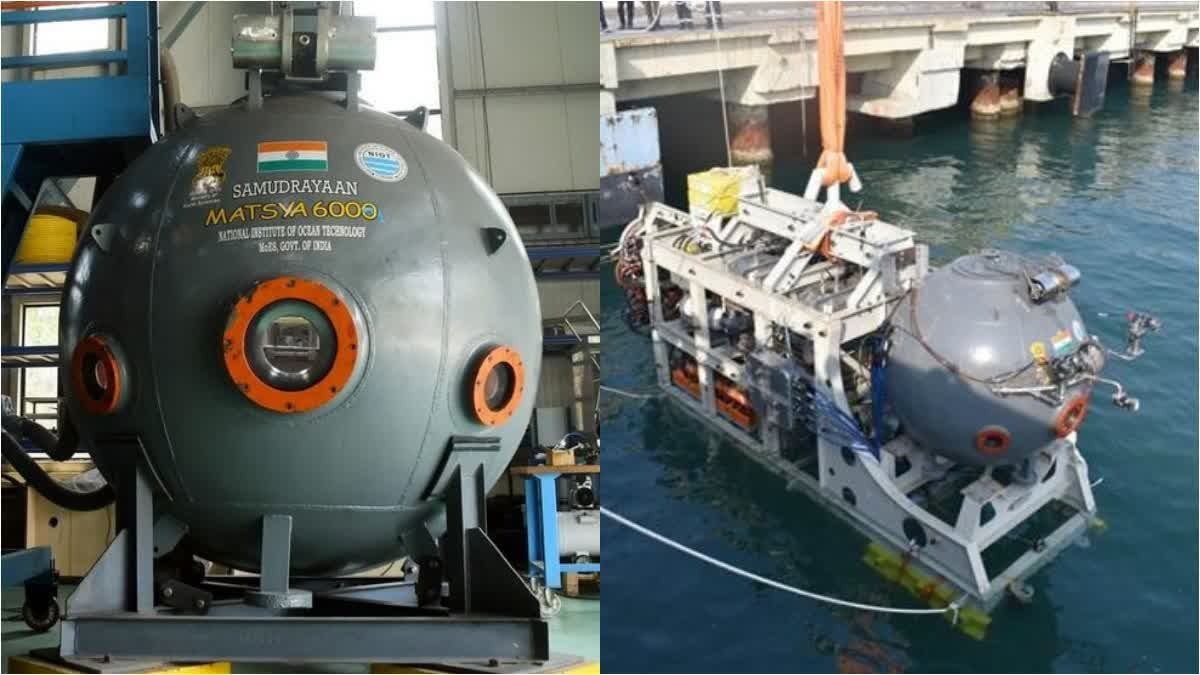Hyderabad: India's fourth-generation deep-ocean submersible Matsya-6000 successfully completed Wet Testing at Kattupalli Port near Chennai. The demonstration phase featured eight dives in total, comprising five unmanned dives and five manned dives, with the latter testing the reliability of the life support system on Matsya.
Following the successful wet test of the Matsya-6000 at the harbour, the National Institute of Ocean Technology aims to conduct shallow-water demonstrations at depths reaching up to 500 metres by the end of 2025.
Matsya-6000 Wet Testing
The Matsya-6000 underwent a comprehensive series of integrated dry tests over a 500-metre operational range, followed by the recent wet test at the L&T Shipbuilding facility located at Kattupalli Port, near Chennai from January 27 to February 12, 2025. The latter also demonstrated the submersible functionality of Matsya.
The tests assessed the submersible's performance across several critical parameters, which include the evaluation of:
- robustness of power and control networks
- floatation and stability of the vehicle
- human support and safety systems
- manoeuvrability within limited degrees of freedom, specifically forward and reverse motion
- navigation and communication capabilities
- scientific payloads, which include oceanographic sensors and more
NIOT noted that underwater voice communication was less effective due to the restricted water depth in the harbour, highlighting the necessity for further testing at greater depths.
"There were problems with underwater communication during the underwater test. This caused difficulties in communicating with the scientists inside. We hope this will be fixed in subsequent tests," NIOT Director Balaji Ramakrishnan said to ETV Bharat.
What's next for Matsya?
Ramakrishnan said that they want to send three scientists from the institute to a depth of 6,000 metres with the primary objective of studying marine life.
"For this, we are upgrading the 'Matsya-6000' submarine system at our campus," Ramakrishnan said, highlighting that the submarine will first have to go through several stages before, starting with the upcoming 500-metre depth test.
Notably, the next step for Matsya-6000 is to undergo a 500-metre depth demonstration. "All the necessary floats are being prepared. The test will be conducted at a depth of 500 meters (1,640 feet) by the end of this year," Ramakrishnan added.
Matsya-6000: India's Fourth-Generation Deep-Ocean Submersible successfully Completes Wet Testing
— PIB India (@PIB_India) February 17, 2025
500-Meter Depth Demonstration by end of 2025
This cutting-edge submersible is engineered to accommodate three humans within its compact 2.1-meter diameter spherical hull
The… pic.twitter.com/kCEPGZc7rq
When asked about the benefits of sending scientists to the deep sea, Ramakrishnan said that automated submersibles equipped with powerful cameras can now reach depths of up to 6,000 meters, but human exploration offers unique advantages. "Scientists can directly observe and bring to light the wonders of the deep sea with their own eyes. Additionally, they can test new technology using their human senses," he added.
"The Matsya-6000 system can operate for 96 hours in an emergency, but it cannot conduct surveys during this time, Ramakrishnan said. "For survey purposes, the system can operate for up to 12 hours. This means it can dive, complete the survey within 12 hours, and return to the sea surface."
Matsya-6000 Submersible: Specifications and features
Under the Government of India's Deep Ocean Mission initiatives, the Ministry of Earth Sciences has entrusted the NIOT with the task of designing and developing the fourth-gen deep-ocean human scientific submersible, named Matsya-6000, under the Samudrayan Project.
The submersible features a spherical hull with a 2.1-metre diameter with an integrated human life-support system. The Matsya-6000 can accommodate up to three humans and features a comprehensive array of components, which include a main ballast system for diving, thrusters for movement in all three directions, a battery bank for power supply, and syntactic foam for buoyancy.
The Matsya-6000 also includes a power distribution network and underwater navigation devices. Communication systems onboard the submersible include an acoustic modem, underwater telephone, and VHF for surface communication, supplemented by underwater acoustic positioning and GPS for precise surface location tracking.
The submersible features cameras outside the hull, whereas the spherical hull includes displays of various environmental/critical parameters, navigation joysticks for manoeuvrability, various oceanographic sensors, and underwater lighting. All these subsystems have been indigenously designed and are currently undergoing thorough integration and qualification testing.
Also read: Matsya-6000 Submersible Passes Test For Human Support And Safety System



